Physical Disability: Concepts, Impacts, and Societal Implications
VerifiedAdded on 2022/12/16
|11
|3152
|91
Homework Assignment
AI Summary
This assignment solution comprehensively addresses the multifaceted aspects of physical disability, beginning with an introduction to the concept and a question-and-answer format to explore key definitions, including centrality, person-centered care, and various types of disabilities such as congenital, acquired, and neurological conditions. The document delves into the emotional impact of progressive disabilities, comparing the effects of congenital and progressive conditions on individuals and families, and analyzing environmental and social barriers. It further examines the socio-economic effects of physical disability, legislative changes, and the impact on life choices. The assignment emphasizes the importance of independence and inclusion, providing practical examples and analysis to promote these values within a supportive environment.
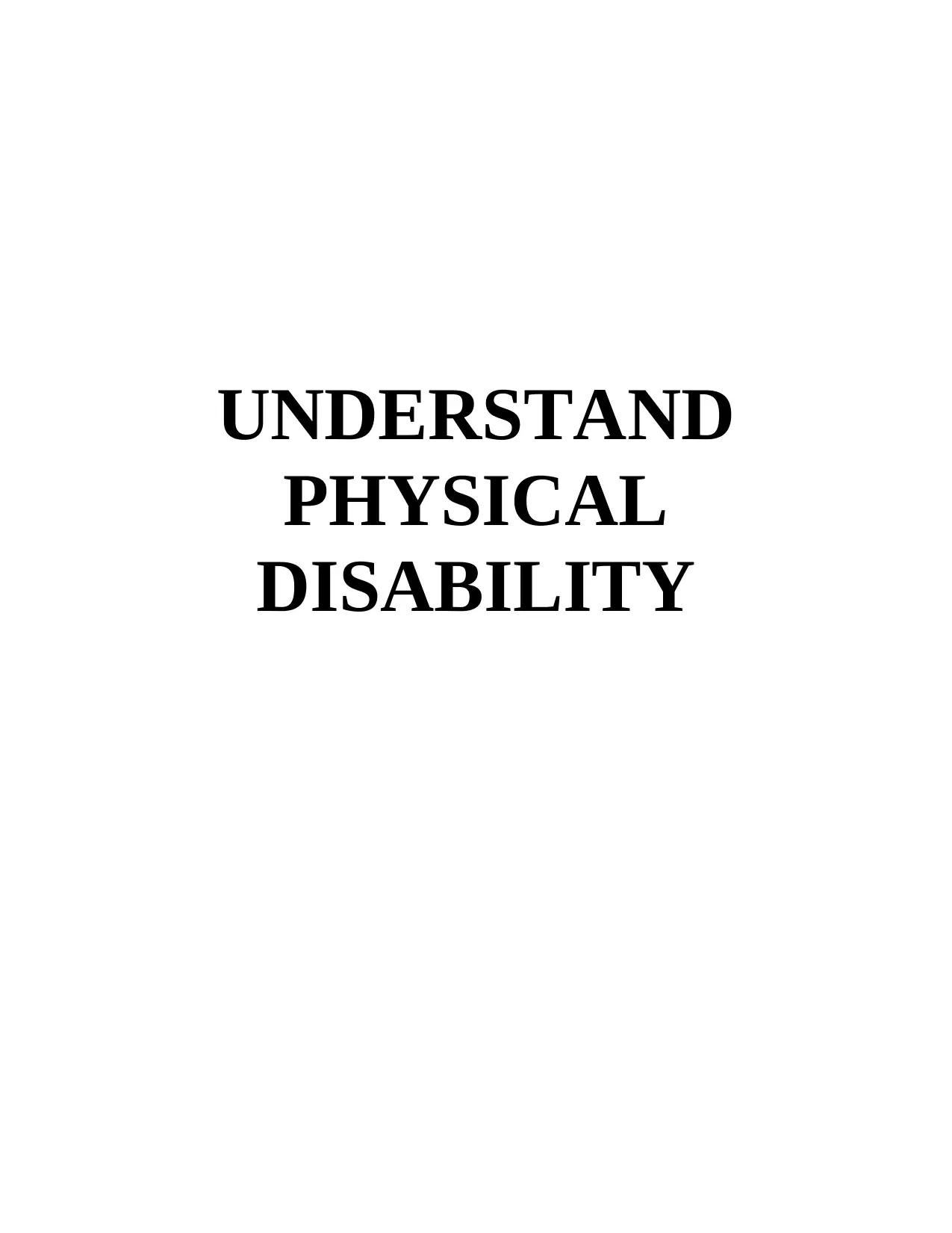
UNDERSTAND
PHYSICAL
DISABILITY
PHYSICAL
DISABILITY
Paraphrase This Document
Need a fresh take? Get an instant paraphrase of this document with our AI Paraphraser
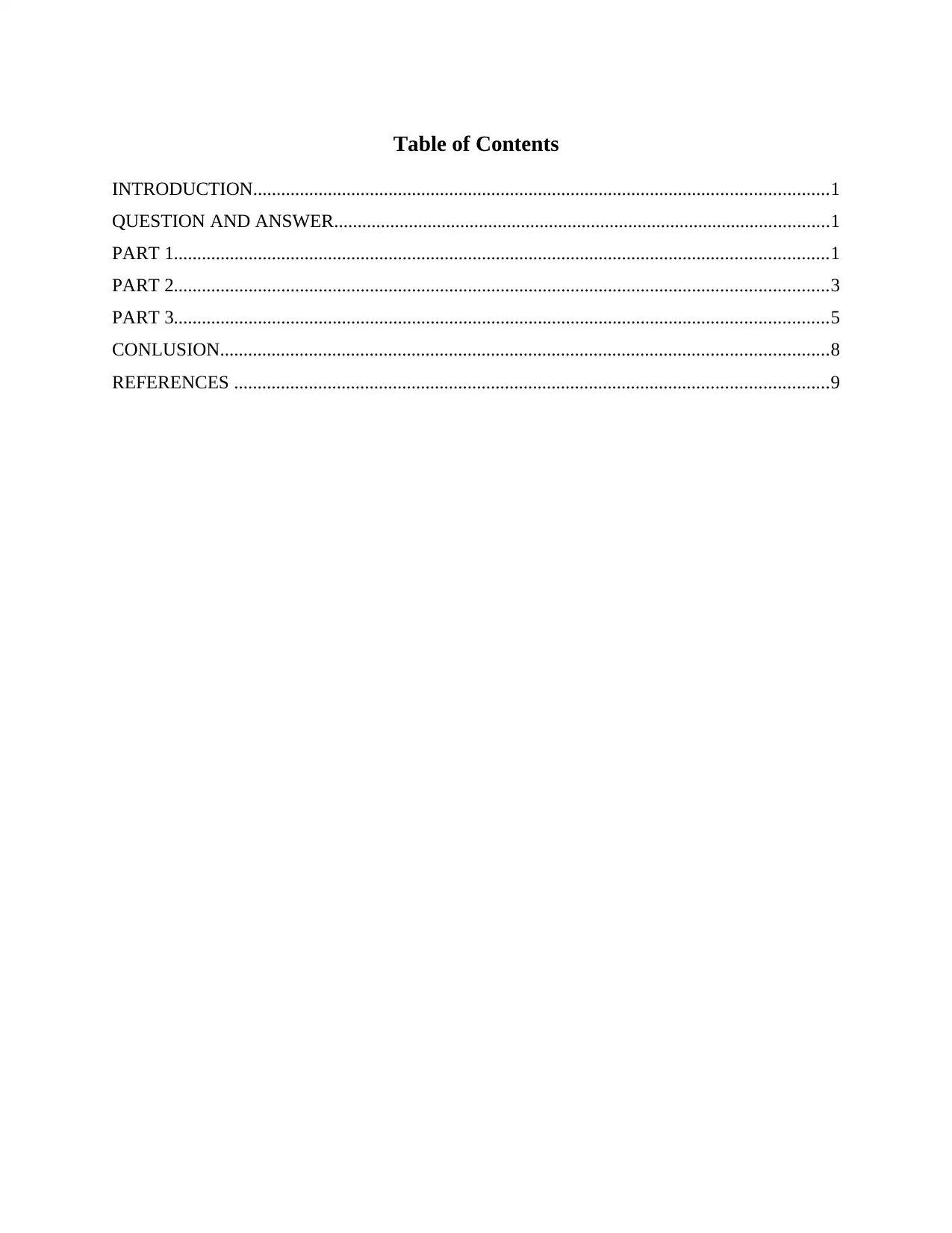
Table of Contents
INTRODUCTION...........................................................................................................................1
QUESTION AND ANSWER..........................................................................................................1
PART 1............................................................................................................................................1
PART 2............................................................................................................................................3
PART 3............................................................................................................................................5
CONLUSION..................................................................................................................................8
REFERENCES ...............................................................................................................................9
INTRODUCTION...........................................................................................................................1
QUESTION AND ANSWER..........................................................................................................1
PART 1............................................................................................................................................1
PART 2............................................................................................................................................3
PART 3............................................................................................................................................5
CONLUSION..................................................................................................................................8
REFERENCES ...............................................................................................................................9
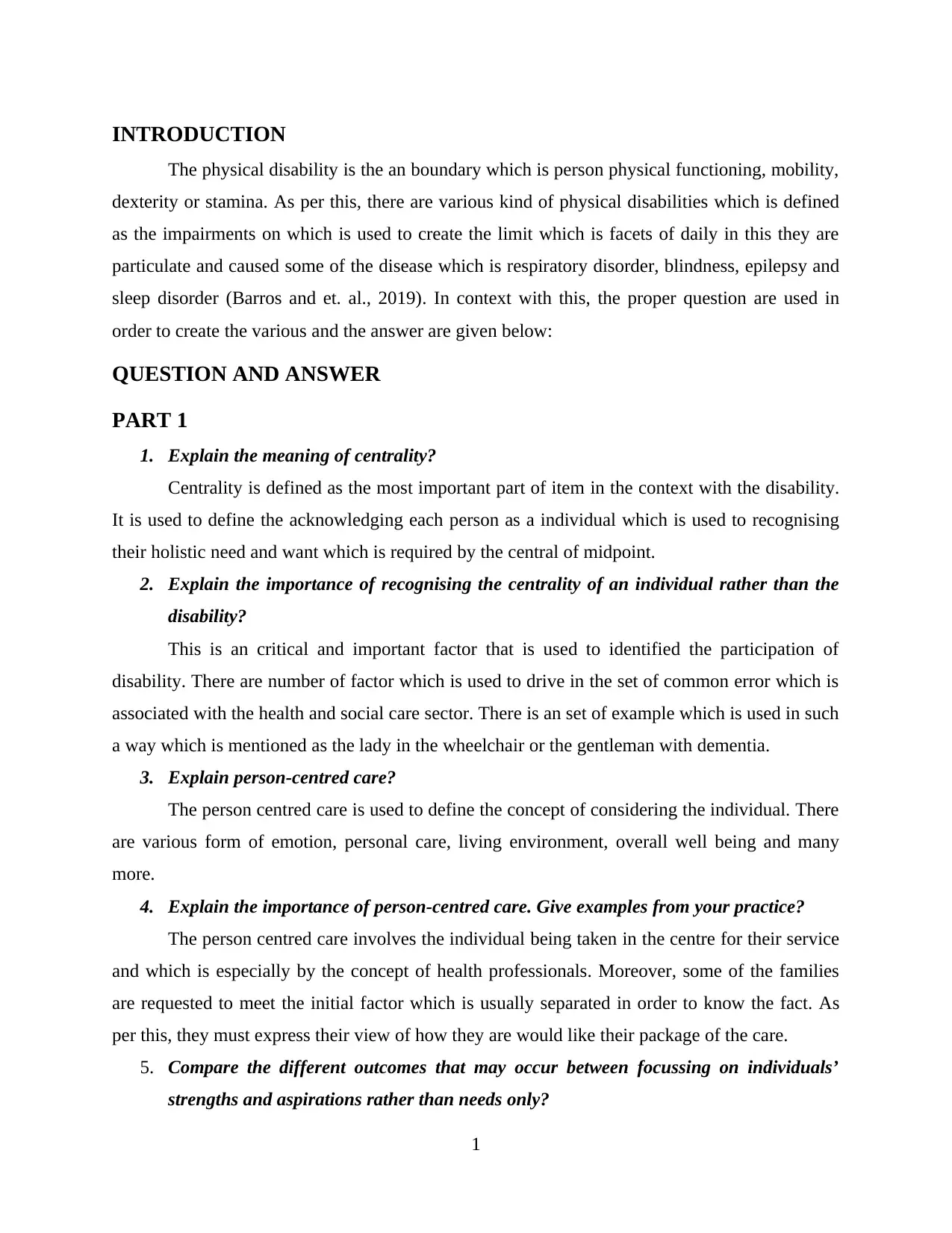
INTRODUCTION
The physical disability is the an boundary which is person physical functioning, mobility,
dexterity or stamina. As per this, there are various kind of physical disabilities which is defined
as the impairments on which is used to create the limit which is facets of daily in this they are
particulate and caused some of the disease which is respiratory disorder, blindness, epilepsy and
sleep disorder (Barros and et. al., 2019). In context with this, the proper question are used in
order to create the various and the answer are given below:
QUESTION AND ANSWER
PART 1
1. Explain the meaning of centrality?
Centrality is defined as the most important part of item in the context with the disability.
It is used to define the acknowledging each person as a individual which is used to recognising
their holistic need and want which is required by the central of midpoint.
2. Explain the importance of recognising the centrality of an individual rather than the
disability?
This is an critical and important factor that is used to identified the participation of
disability. There are number of factor which is used to drive in the set of common error which is
associated with the health and social care sector. There is an set of example which is used in such
a way which is mentioned as the lady in the wheelchair or the gentleman with dementia.
3. Explain person-centred care?
The person centred care is used to define the concept of considering the individual. There
are various form of emotion, personal care, living environment, overall well being and many
more.
4. Explain the importance of person-centred care. Give examples from your practice?
The person centred care involves the individual being taken in the centre for their service
and which is especially by the concept of health professionals. Moreover, some of the families
are requested to meet the initial factor which is usually separated in order to know the fact. As
per this, they must express their view of how they are would like their package of the care.
5. Compare the different outcomes that may occur between focussing on individuals’
strengths and aspirations rather than needs only?
1
The physical disability is the an boundary which is person physical functioning, mobility,
dexterity or stamina. As per this, there are various kind of physical disabilities which is defined
as the impairments on which is used to create the limit which is facets of daily in this they are
particulate and caused some of the disease which is respiratory disorder, blindness, epilepsy and
sleep disorder (Barros and et. al., 2019). In context with this, the proper question are used in
order to create the various and the answer are given below:
QUESTION AND ANSWER
PART 1
1. Explain the meaning of centrality?
Centrality is defined as the most important part of item in the context with the disability.
It is used to define the acknowledging each person as a individual which is used to recognising
their holistic need and want which is required by the central of midpoint.
2. Explain the importance of recognising the centrality of an individual rather than the
disability?
This is an critical and important factor that is used to identified the participation of
disability. There are number of factor which is used to drive in the set of common error which is
associated with the health and social care sector. There is an set of example which is used in such
a way which is mentioned as the lady in the wheelchair or the gentleman with dementia.
3. Explain person-centred care?
The person centred care is used to define the concept of considering the individual. There
are various form of emotion, personal care, living environment, overall well being and many
more.
4. Explain the importance of person-centred care. Give examples from your practice?
The person centred care involves the individual being taken in the centre for their service
and which is especially by the concept of health professionals. Moreover, some of the families
are requested to meet the initial factor which is usually separated in order to know the fact. As
per this, they must express their view of how they are would like their package of the care.
5. Compare the different outcomes that may occur between focussing on individuals’
strengths and aspirations rather than needs only?
1
⊘ This is a preview!⊘
Do you want full access?
Subscribe today to unlock all pages.

Trusted by 1+ million students worldwide
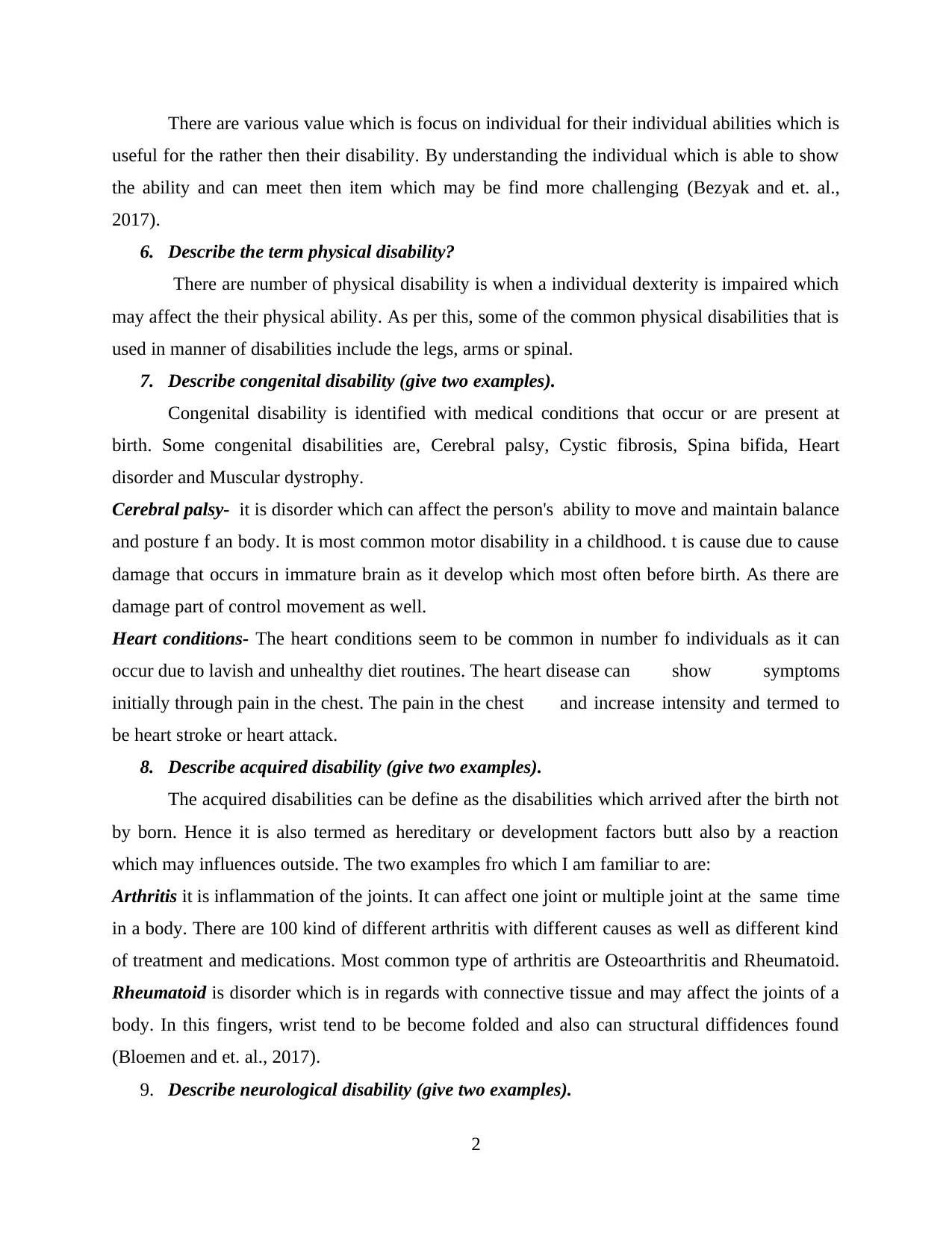
There are various value which is focus on individual for their individual abilities which is
useful for the rather then their disability. By understanding the individual which is able to show
the ability and can meet then item which may be find more challenging (Bezyak and et. al.,
2017).
6. Describe the term physical disability?
There are number of physical disability is when a individual dexterity is impaired which
may affect the their physical ability. As per this, some of the common physical disabilities that is
used in manner of disabilities include the legs, arms or spinal.
7. Describe congenital disability (give two examples).
Congenital disability is identified with medical conditions that occur or are present at
birth. Some congenital disabilities are, Cerebral palsy, Cystic fibrosis, Spina bifida, Heart
disorder and Muscular dystrophy.
Cerebral palsy- it is disorder which can affect the person's ability to move and maintain balance
and posture f an body. It is most common motor disability in a childhood. t is cause due to cause
damage that occurs in immature brain as it develop which most often before birth. As there are
damage part of control movement as well.
Heart conditions- The heart conditions seem to be common in number fo individuals as it can
occur due to lavish and unhealthy diet routines. The heart disease can show symptoms
initially through pain in the chest. The pain in the chest and increase intensity and termed to
be heart stroke or heart attack.
8. Describe acquired disability (give two examples).
The acquired disabilities can be define as the disabilities which arrived after the birth not
by born. Hence it is also termed as hereditary or development factors butt also by a reaction
which may influences outside. The two examples fro which I am familiar to are:
Arthritis it is inflammation of the joints. It can affect one joint or multiple joint at the same time
in a body. There are 100 kind of different arthritis with different causes as well as different kind
of treatment and medications. Most common type of arthritis are Osteoarthritis and Rheumatoid.
Rheumatoid is disorder which is in regards with connective tissue and may affect the joints of a
body. In this fingers, wrist tend to be become folded and also can structural diffidences found
(Bloemen and et. al., 2017).
9. Describe neurological disability (give two examples).
2
useful for the rather then their disability. By understanding the individual which is able to show
the ability and can meet then item which may be find more challenging (Bezyak and et. al.,
2017).
6. Describe the term physical disability?
There are number of physical disability is when a individual dexterity is impaired which
may affect the their physical ability. As per this, some of the common physical disabilities that is
used in manner of disabilities include the legs, arms or spinal.
7. Describe congenital disability (give two examples).
Congenital disability is identified with medical conditions that occur or are present at
birth. Some congenital disabilities are, Cerebral palsy, Cystic fibrosis, Spina bifida, Heart
disorder and Muscular dystrophy.
Cerebral palsy- it is disorder which can affect the person's ability to move and maintain balance
and posture f an body. It is most common motor disability in a childhood. t is cause due to cause
damage that occurs in immature brain as it develop which most often before birth. As there are
damage part of control movement as well.
Heart conditions- The heart conditions seem to be common in number fo individuals as it can
occur due to lavish and unhealthy diet routines. The heart disease can show symptoms
initially through pain in the chest. The pain in the chest and increase intensity and termed to
be heart stroke or heart attack.
8. Describe acquired disability (give two examples).
The acquired disabilities can be define as the disabilities which arrived after the birth not
by born. Hence it is also termed as hereditary or development factors butt also by a reaction
which may influences outside. The two examples fro which I am familiar to are:
Arthritis it is inflammation of the joints. It can affect one joint or multiple joint at the same time
in a body. There are 100 kind of different arthritis with different causes as well as different kind
of treatment and medications. Most common type of arthritis are Osteoarthritis and Rheumatoid.
Rheumatoid is disorder which is in regards with connective tissue and may affect the joints of a
body. In this fingers, wrist tend to be become folded and also can structural diffidences found
(Bloemen and et. al., 2017).
9. Describe neurological disability (give two examples).
2
Paraphrase This Document
Need a fresh take? Get an instant paraphrase of this document with our AI Paraphraser
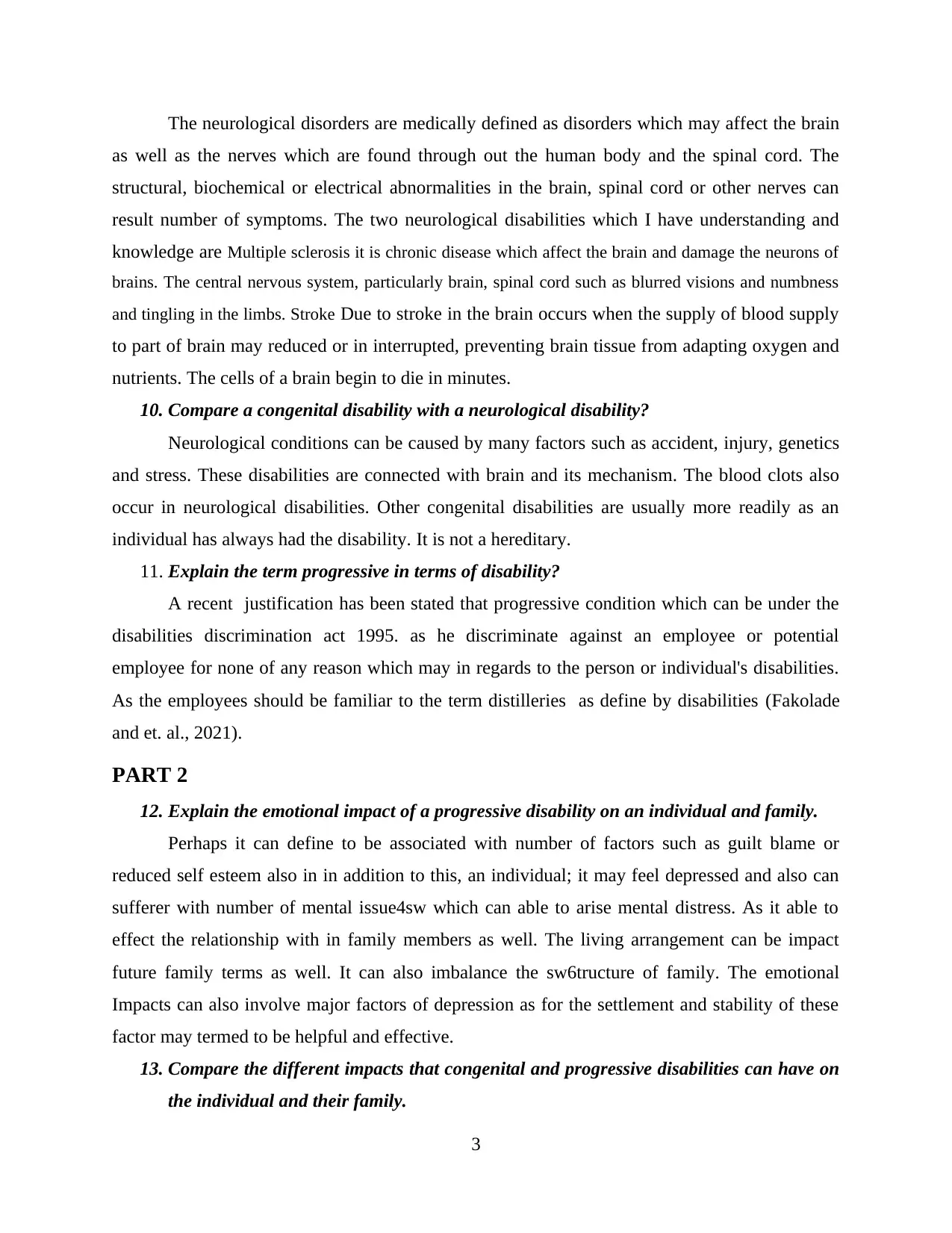
The neurological disorders are medically defined as disorders which may affect the brain
as well as the nerves which are found through out the human body and the spinal cord. The
structural, biochemical or electrical abnormalities in the brain, spinal cord or other nerves can
result number of symptoms. The two neurological disabilities which I have understanding and
knowledge are Multiple sclerosis it is chronic disease which affect the brain and damage the neurons of
brains. The central nervous system, particularly brain, spinal cord such as blurred visions and numbness
and tingling in the limbs. Stroke Due to stroke in the brain occurs when the supply of blood supply
to part of brain may reduced or in interrupted, preventing brain tissue from adapting oxygen and
nutrients. The cells of a brain begin to die in minutes.
10. Compare a congenital disability with a neurological disability?
Neurological conditions can be caused by many factors such as accident, injury, genetics
and stress. These disabilities are connected with brain and its mechanism. The blood clots also
occur in neurological disabilities. Other congenital disabilities are usually more readily as an
individual has always had the disability. It is not a hereditary.
11. Explain the term progressive in terms of disability?
A recent justification has been stated that progressive condition which can be under the
disabilities discrimination act 1995. as he discriminate against an employee or potential
employee for none of any reason which may in regards to the person or individual's disabilities.
As the employees should be familiar to the term distilleries as define by disabilities (Fakolade
and et. al., 2021).
PART 2
12. Explain the emotional impact of a progressive disability on an individual and family.
Perhaps it can define to be associated with number of factors such as guilt blame or
reduced self esteem also in in addition to this, an individual; it may feel depressed and also can
sufferer with number of mental issue4sw which can able to arise mental distress. As it able to
effect the relationship with in family members as well. The living arrangement can be impact
future family terms as well. It can also imbalance the sw6tructure of family. The emotional
Impacts can also involve major factors of depression as for the settlement and stability of these
factor may termed to be helpful and effective.
13. Compare the different impacts that congenital and progressive disabilities can have on
the individual and their family.
3
as well as the nerves which are found through out the human body and the spinal cord. The
structural, biochemical or electrical abnormalities in the brain, spinal cord or other nerves can
result number of symptoms. The two neurological disabilities which I have understanding and
knowledge are Multiple sclerosis it is chronic disease which affect the brain and damage the neurons of
brains. The central nervous system, particularly brain, spinal cord such as blurred visions and numbness
and tingling in the limbs. Stroke Due to stroke in the brain occurs when the supply of blood supply
to part of brain may reduced or in interrupted, preventing brain tissue from adapting oxygen and
nutrients. The cells of a brain begin to die in minutes.
10. Compare a congenital disability with a neurological disability?
Neurological conditions can be caused by many factors such as accident, injury, genetics
and stress. These disabilities are connected with brain and its mechanism. The blood clots also
occur in neurological disabilities. Other congenital disabilities are usually more readily as an
individual has always had the disability. It is not a hereditary.
11. Explain the term progressive in terms of disability?
A recent justification has been stated that progressive condition which can be under the
disabilities discrimination act 1995. as he discriminate against an employee or potential
employee for none of any reason which may in regards to the person or individual's disabilities.
As the employees should be familiar to the term distilleries as define by disabilities (Fakolade
and et. al., 2021).
PART 2
12. Explain the emotional impact of a progressive disability on an individual and family.
Perhaps it can define to be associated with number of factors such as guilt blame or
reduced self esteem also in in addition to this, an individual; it may feel depressed and also can
sufferer with number of mental issue4sw which can able to arise mental distress. As it able to
effect the relationship with in family members as well. The living arrangement can be impact
future family terms as well. It can also imbalance the sw6tructure of family. The emotional
Impacts can also involve major factors of depression as for the settlement and stability of these
factor may termed to be helpful and effective.
13. Compare the different impacts that congenital and progressive disabilities can have on
the individual and their family.
3
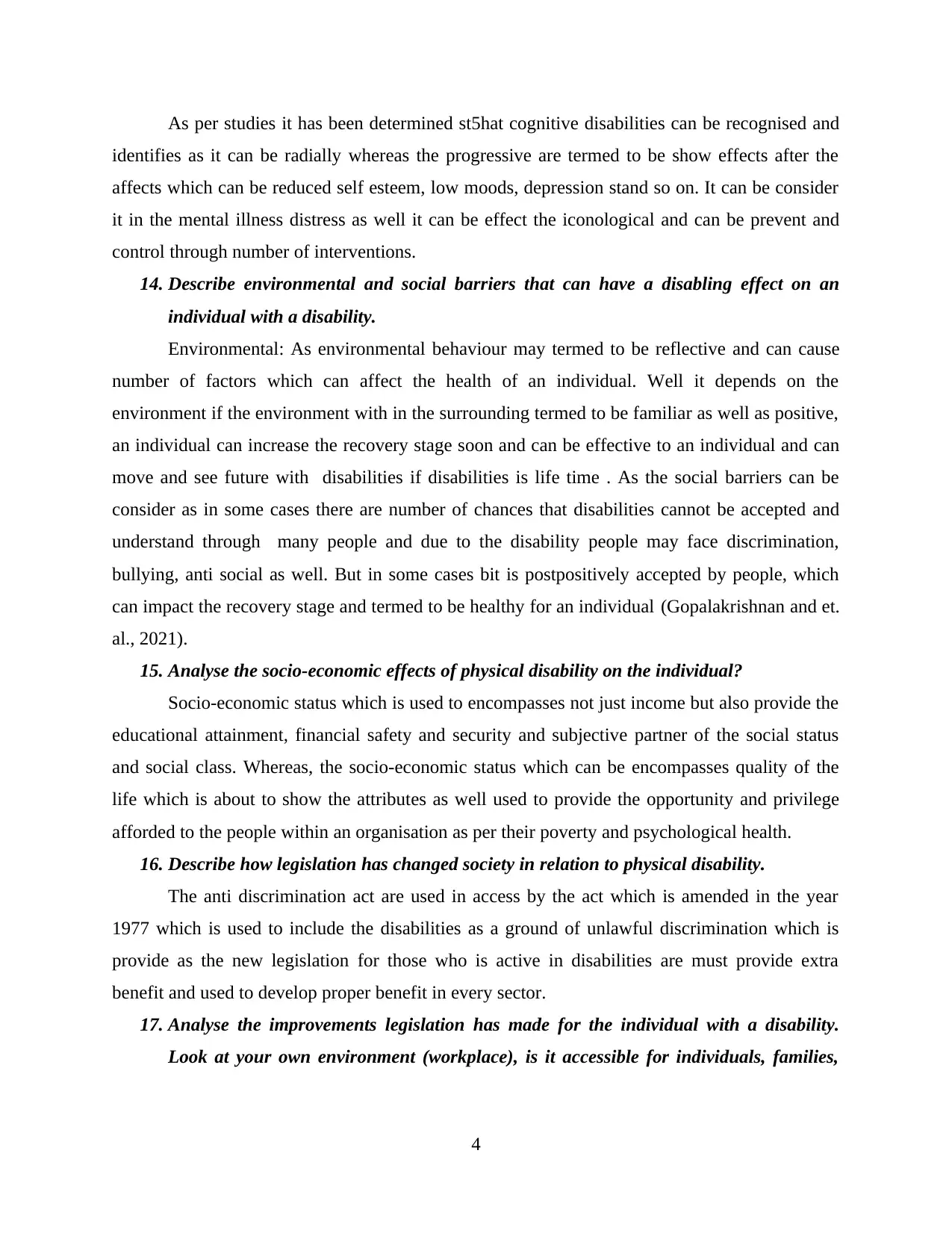
As per studies it has been determined st5hat cognitive disabilities can be recognised and
identifies as it can be radially whereas the progressive are termed to be show effects after the
affects which can be reduced self esteem, low moods, depression stand so on. It can be consider
it in the mental illness distress as well it can be effect the iconological and can be prevent and
control through number of interventions.
14. Describe environmental and social barriers that can have a disabling effect on an
individual with a disability.
Environmental: As environmental behaviour may termed to be reflective and can cause
number of factors which can affect the health of an individual. Well it depends on the
environment if the environment with in the surrounding termed to be familiar as well as positive,
an individual can increase the recovery stage soon and can be effective to an individual and can
move and see future with disabilities if disabilities is life time . As the social barriers can be
consider as in some cases there are number of chances that disabilities cannot be accepted and
understand through many people and due to the disability people may face discrimination,
bullying, anti social as well. But in some cases bit is postpositively accepted by people, which
can impact the recovery stage and termed to be healthy for an individual (Gopalakrishnan and et.
al., 2021).
15. Analyse the socio-economic effects of physical disability on the individual?
Socio-economic status which is used to encompasses not just income but also provide the
educational attainment, financial safety and security and subjective partner of the social status
and social class. Whereas, the socio-economic status which can be encompasses quality of the
life which is about to show the attributes as well used to provide the opportunity and privilege
afforded to the people within an organisation as per their poverty and psychological health.
16. Describe how legislation has changed society in relation to physical disability.
The anti discrimination act are used in access by the act which is amended in the year
1977 which is used to include the disabilities as a ground of unlawful discrimination which is
provide as the new legislation for those who is active in disabilities are must provide extra
benefit and used to develop proper benefit in every sector.
17. Analyse the improvements legislation has made for the individual with a disability.
Look at your own environment (workplace), is it accessible for individuals, families,
4
identifies as it can be radially whereas the progressive are termed to be show effects after the
affects which can be reduced self esteem, low moods, depression stand so on. It can be consider
it in the mental illness distress as well it can be effect the iconological and can be prevent and
control through number of interventions.
14. Describe environmental and social barriers that can have a disabling effect on an
individual with a disability.
Environmental: As environmental behaviour may termed to be reflective and can cause
number of factors which can affect the health of an individual. Well it depends on the
environment if the environment with in the surrounding termed to be familiar as well as positive,
an individual can increase the recovery stage soon and can be effective to an individual and can
move and see future with disabilities if disabilities is life time . As the social barriers can be
consider as in some cases there are number of chances that disabilities cannot be accepted and
understand through many people and due to the disability people may face discrimination,
bullying, anti social as well. But in some cases bit is postpositively accepted by people, which
can impact the recovery stage and termed to be healthy for an individual (Gopalakrishnan and et.
al., 2021).
15. Analyse the socio-economic effects of physical disability on the individual?
Socio-economic status which is used to encompasses not just income but also provide the
educational attainment, financial safety and security and subjective partner of the social status
and social class. Whereas, the socio-economic status which can be encompasses quality of the
life which is about to show the attributes as well used to provide the opportunity and privilege
afforded to the people within an organisation as per their poverty and psychological health.
16. Describe how legislation has changed society in relation to physical disability.
The anti discrimination act are used in access by the act which is amended in the year
1977 which is used to include the disabilities as a ground of unlawful discrimination which is
provide as the new legislation for those who is active in disabilities are must provide extra
benefit and used to develop proper benefit in every sector.
17. Analyse the improvements legislation has made for the individual with a disability.
Look at your own environment (workplace), is it accessible for individuals, families,
4
⊘ This is a preview!⊘
Do you want full access?
Subscribe today to unlock all pages.

Trusted by 1+ million students worldwide
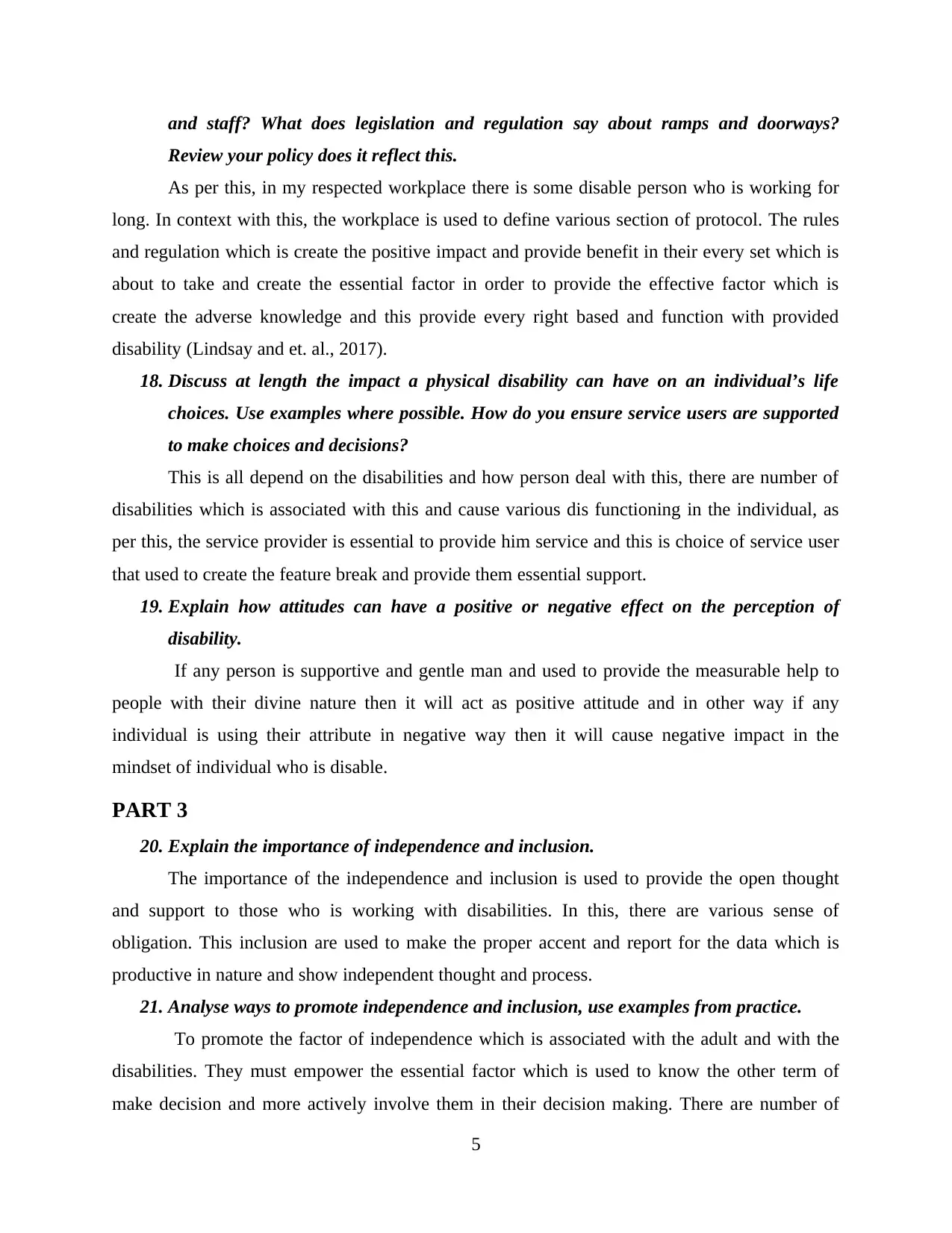
and staff? What does legislation and regulation say about ramps and doorways?
Review your policy does it reflect this.
As per this, in my respected workplace there is some disable person who is working for
long. In context with this, the workplace is used to define various section of protocol. The rules
and regulation which is create the positive impact and provide benefit in their every set which is
about to take and create the essential factor in order to provide the effective factor which is
create the adverse knowledge and this provide every right based and function with provided
disability (Lindsay and et. al., 2017).
18. Discuss at length the impact a physical disability can have on an individual’s life
choices. Use examples where possible. How do you ensure service users are supported
to make choices and decisions?
This is all depend on the disabilities and how person deal with this, there are number of
disabilities which is associated with this and cause various dis functioning in the individual, as
per this, the service provider is essential to provide him service and this is choice of service user
that used to create the feature break and provide them essential support.
19. Explain how attitudes can have a positive or negative effect on the perception of
disability.
If any person is supportive and gentle man and used to provide the measurable help to
people with their divine nature then it will act as positive attitude and in other way if any
individual is using their attribute in negative way then it will cause negative impact in the
mindset of individual who is disable.
PART 3
20. Explain the importance of independence and inclusion.
The importance of the independence and inclusion is used to provide the open thought
and support to those who is working with disabilities. In this, there are various sense of
obligation. This inclusion are used to make the proper accent and report for the data which is
productive in nature and show independent thought and process.
21. Analyse ways to promote independence and inclusion, use examples from practice.
To promote the factor of independence which is associated with the adult and with the
disabilities. They must empower the essential factor which is used to know the other term of
make decision and more actively involve them in their decision making. There are number of
5
Review your policy does it reflect this.
As per this, in my respected workplace there is some disable person who is working for
long. In context with this, the workplace is used to define various section of protocol. The rules
and regulation which is create the positive impact and provide benefit in their every set which is
about to take and create the essential factor in order to provide the effective factor which is
create the adverse knowledge and this provide every right based and function with provided
disability (Lindsay and et. al., 2017).
18. Discuss at length the impact a physical disability can have on an individual’s life
choices. Use examples where possible. How do you ensure service users are supported
to make choices and decisions?
This is all depend on the disabilities and how person deal with this, there are number of
disabilities which is associated with this and cause various dis functioning in the individual, as
per this, the service provider is essential to provide him service and this is choice of service user
that used to create the feature break and provide them essential support.
19. Explain how attitudes can have a positive or negative effect on the perception of
disability.
If any person is supportive and gentle man and used to provide the measurable help to
people with their divine nature then it will act as positive attitude and in other way if any
individual is using their attribute in negative way then it will cause negative impact in the
mindset of individual who is disable.
PART 3
20. Explain the importance of independence and inclusion.
The importance of the independence and inclusion is used to provide the open thought
and support to those who is working with disabilities. In this, there are various sense of
obligation. This inclusion are used to make the proper accent and report for the data which is
productive in nature and show independent thought and process.
21. Analyse ways to promote independence and inclusion, use examples from practice.
To promote the factor of independence which is associated with the adult and with the
disabilities. They must empower the essential factor which is used to know the other term of
make decision and more actively involve them in their decision making. There are number of
5
Paraphrase This Document
Need a fresh take? Get an instant paraphrase of this document with our AI Paraphraser
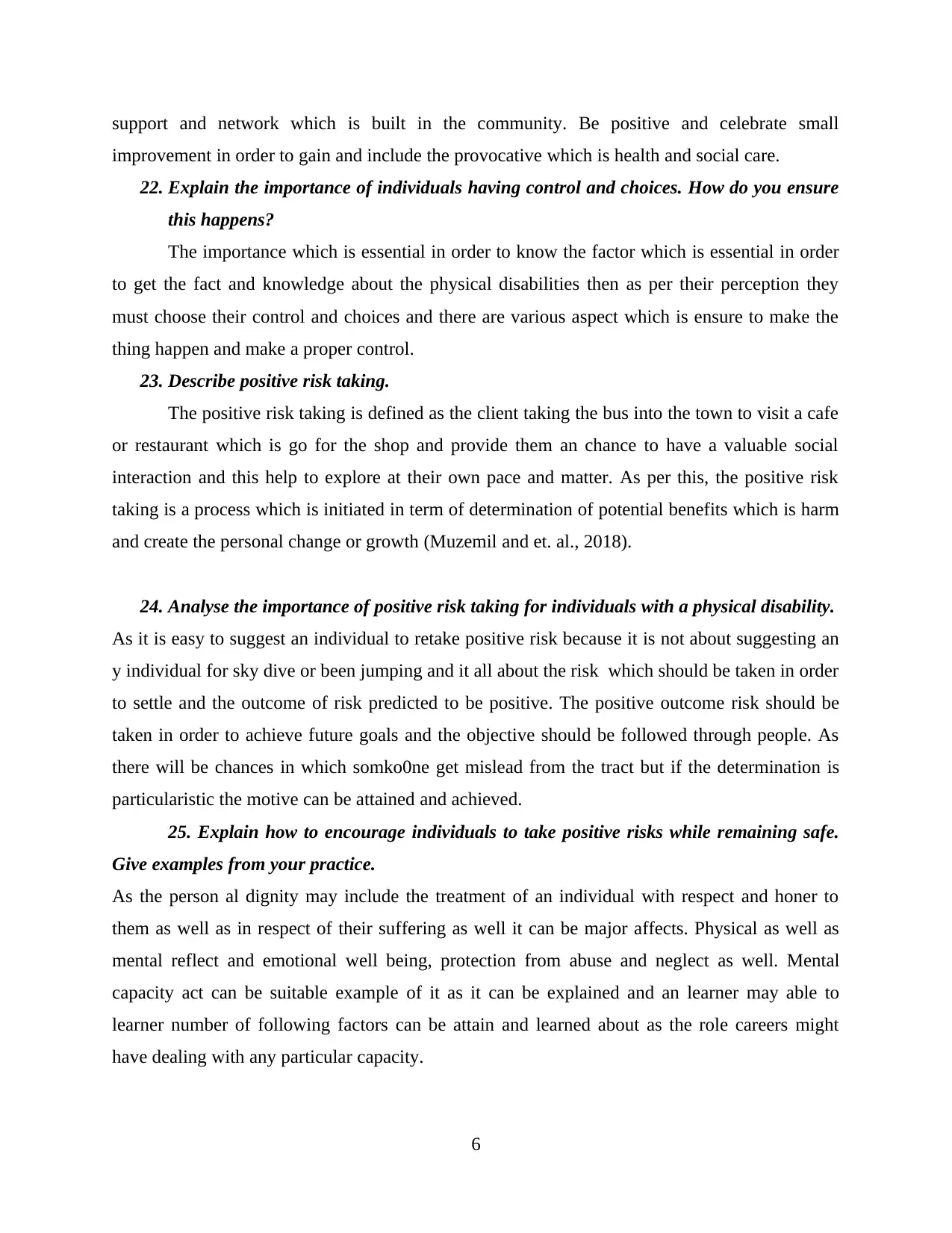
support and network which is built in the community. Be positive and celebrate small
improvement in order to gain and include the provocative which is health and social care.
22. Explain the importance of individuals having control and choices. How do you ensure
this happens?
The importance which is essential in order to know the factor which is essential in order
to get the fact and knowledge about the physical disabilities then as per their perception they
must choose their control and choices and there are various aspect which is ensure to make the
thing happen and make a proper control.
23. Describe positive risk taking.
The positive risk taking is defined as the client taking the bus into the town to visit a cafe
or restaurant which is go for the shop and provide them an chance to have a valuable social
interaction and this help to explore at their own pace and matter. As per this, the positive risk
taking is a process which is initiated in term of determination of potential benefits which is harm
and create the personal change or growth (Muzemil and et. al., 2018).
24. Analyse the importance of positive risk taking for individuals with a physical disability.
As it is easy to suggest an individual to retake positive risk because it is not about suggesting an
y individual for sky dive or been jumping and it all about the risk which should be taken in order
to settle and the outcome of risk predicted to be positive. The positive outcome risk should be
taken in order to achieve future goals and the objective should be followed through people. As
there will be chances in which somko0ne get mislead from the tract but if the determination is
particularistic the motive can be attained and achieved.
25. Explain how to encourage individuals to take positive risks while remaining safe.
Give examples from your practice.
As the person al dignity may include the treatment of an individual with respect and honer to
them as well as in respect of their suffering as well it can be major affects. Physical as well as
mental reflect and emotional well being, protection from abuse and neglect as well. Mental
capacity act can be suitable example of it as it can be explained and an learner may able to
learner number of following factors can be attain and learned about as the role careers might
have dealing with any particular capacity.
6
improvement in order to gain and include the provocative which is health and social care.
22. Explain the importance of individuals having control and choices. How do you ensure
this happens?
The importance which is essential in order to know the factor which is essential in order
to get the fact and knowledge about the physical disabilities then as per their perception they
must choose their control and choices and there are various aspect which is ensure to make the
thing happen and make a proper control.
23. Describe positive risk taking.
The positive risk taking is defined as the client taking the bus into the town to visit a cafe
or restaurant which is go for the shop and provide them an chance to have a valuable social
interaction and this help to explore at their own pace and matter. As per this, the positive risk
taking is a process which is initiated in term of determination of potential benefits which is harm
and create the personal change or growth (Muzemil and et. al., 2018).
24. Analyse the importance of positive risk taking for individuals with a physical disability.
As it is easy to suggest an individual to retake positive risk because it is not about suggesting an
y individual for sky dive or been jumping and it all about the risk which should be taken in order
to settle and the outcome of risk predicted to be positive. The positive outcome risk should be
taken in order to achieve future goals and the objective should be followed through people. As
there will be chances in which somko0ne get mislead from the tract but if the determination is
particularistic the motive can be attained and achieved.
25. Explain how to encourage individuals to take positive risks while remaining safe.
Give examples from your practice.
As the person al dignity may include the treatment of an individual with respect and honer to
them as well as in respect of their suffering as well it can be major affects. Physical as well as
mental reflect and emotional well being, protection from abuse and neglect as well. Mental
capacity act can be suitable example of it as it can be explained and an learner may able to
learner number of following factors can be attain and learned about as the role careers might
have dealing with any particular capacity.
6
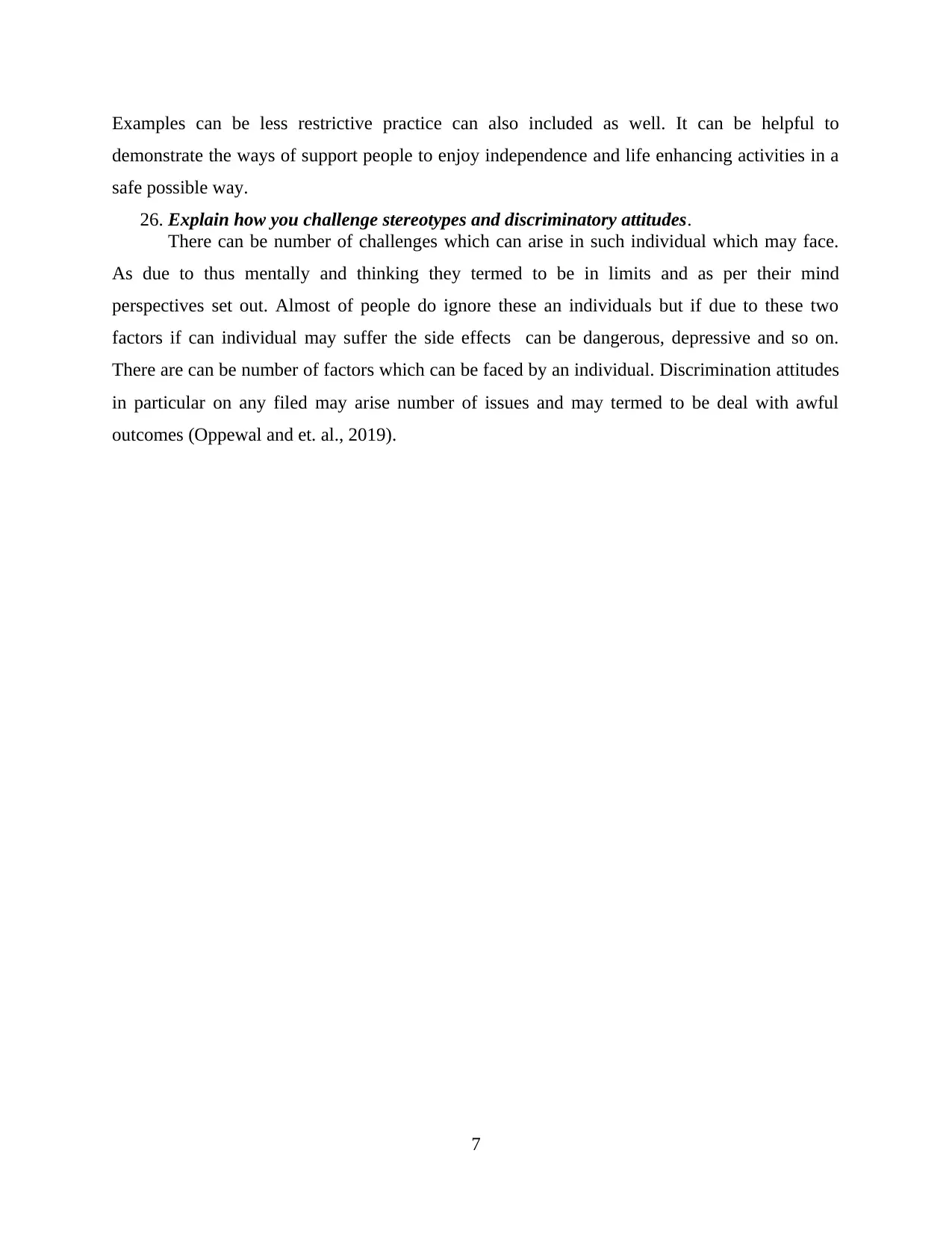
Examples can be less restrictive practice can also included as well. It can be helpful to
demonstrate the ways of support people to enjoy independence and life enhancing activities in a
safe possible way.
26. Explain how you challenge stereotypes and discriminatory attitudes.
There can be number of challenges which can arise in such individual which may face.
As due to thus mentally and thinking they termed to be in limits and as per their mind
perspectives set out. Almost of people do ignore these an individuals but if due to these two
factors if can individual may suffer the side effects can be dangerous, depressive and so on.
There are can be number of factors which can be faced by an individual. Discrimination attitudes
in particular on any filed may arise number of issues and may termed to be deal with awful
outcomes (Oppewal and et. al., 2019).
7
demonstrate the ways of support people to enjoy independence and life enhancing activities in a
safe possible way.
26. Explain how you challenge stereotypes and discriminatory attitudes.
There can be number of challenges which can arise in such individual which may face.
As due to thus mentally and thinking they termed to be in limits and as per their mind
perspectives set out. Almost of people do ignore these an individuals but if due to these two
factors if can individual may suffer the side effects can be dangerous, depressive and so on.
There are can be number of factors which can be faced by an individual. Discrimination attitudes
in particular on any filed may arise number of issues and may termed to be deal with awful
outcomes (Oppewal and et. al., 2019).
7
⊘ This is a preview!⊘
Do you want full access?
Subscribe today to unlock all pages.

Trusted by 1+ million students worldwide

CONLUSION
As per the above discussion, this is well analyse that the disabilities of a person is created
the limitation and boundaries which is used to create various factor in their respected workplace.
The proper law and regulation are used in this with a legislation process are create
accomplishment.
8
As per the above discussion, this is well analyse that the disabilities of a person is created
the limitation and boundaries which is used to create various factor in their respected workplace.
The proper law and regulation are used in this with a legislation process are create
accomplishment.
8
Paraphrase This Document
Need a fresh take? Get an instant paraphrase of this document with our AI Paraphraser
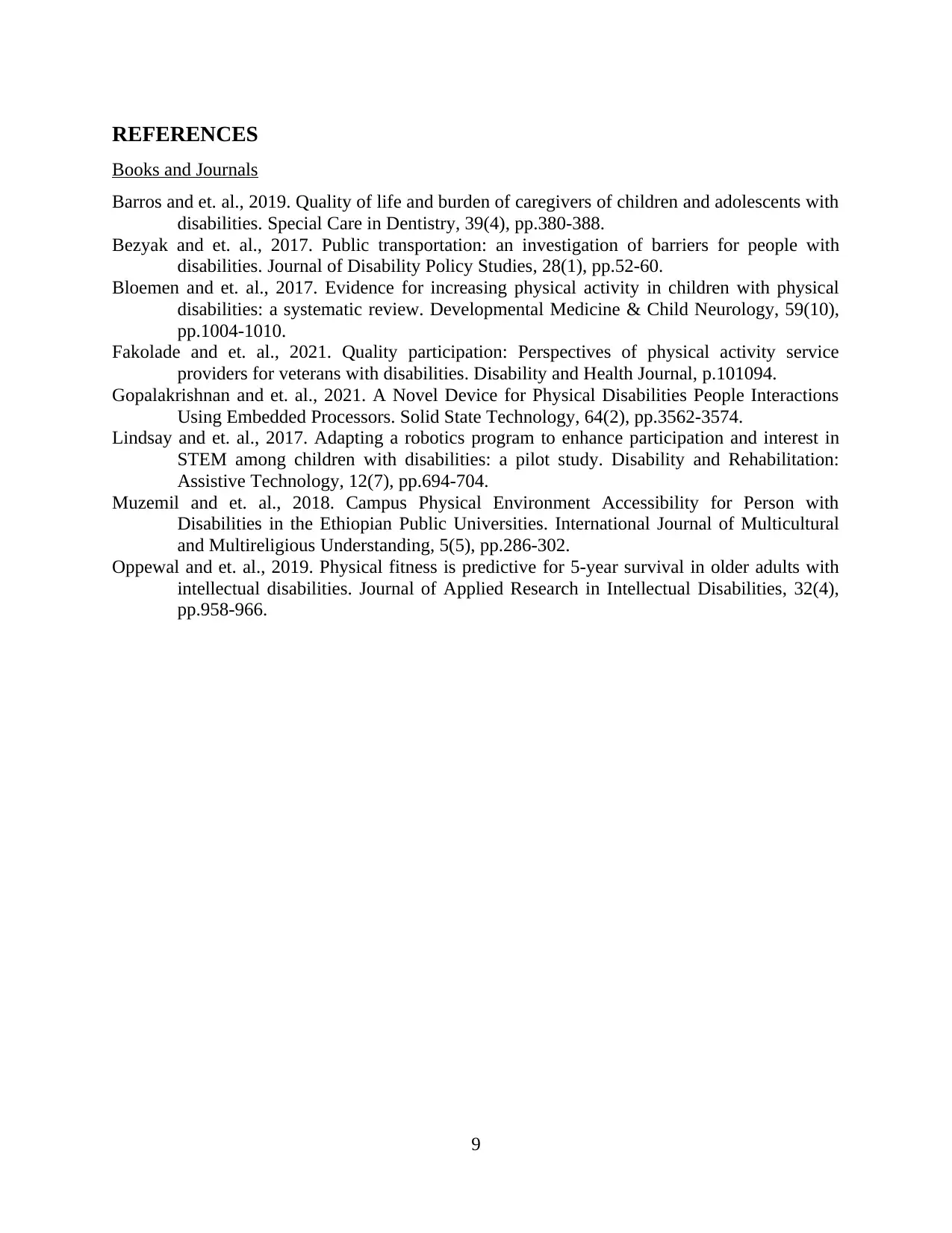
REFERENCES
Books and Journals
Barros and et. al., 2019. Quality of life and burden of caregivers of children and adolescents with
disabilities. Special Care in Dentistry, 39(4), pp.380-388.
Bezyak and et. al., 2017. Public transportation: an investigation of barriers for people with
disabilities. Journal of Disability Policy Studies, 28(1), pp.52-60.
Bloemen and et. al., 2017. Evidence for increasing physical activity in children with physical
disabilities: a systematic review. Developmental Medicine & Child Neurology, 59(10),
pp.1004-1010.
Fakolade and et. al., 2021. Quality participation: Perspectives of physical activity service
providers for veterans with disabilities. Disability and Health Journal, p.101094.
Gopalakrishnan and et. al., 2021. A Novel Device for Physical Disabilities People Interactions
Using Embedded Processors. Solid State Technology, 64(2), pp.3562-3574.
Lindsay and et. al., 2017. Adapting a robotics program to enhance participation and interest in
STEM among children with disabilities: a pilot study. Disability and Rehabilitation:
Assistive Technology, 12(7), pp.694-704.
Muzemil and et. al., 2018. Campus Physical Environment Accessibility for Person with
Disabilities in the Ethiopian Public Universities. International Journal of Multicultural
and Multireligious Understanding, 5(5), pp.286-302.
Oppewal and et. al., 2019. Physical fitness is predictive for 5‐year survival in older adults with
intellectual disabilities. Journal of Applied Research in Intellectual Disabilities, 32(4),
pp.958-966.
9
Books and Journals
Barros and et. al., 2019. Quality of life and burden of caregivers of children and adolescents with
disabilities. Special Care in Dentistry, 39(4), pp.380-388.
Bezyak and et. al., 2017. Public transportation: an investigation of barriers for people with
disabilities. Journal of Disability Policy Studies, 28(1), pp.52-60.
Bloemen and et. al., 2017. Evidence for increasing physical activity in children with physical
disabilities: a systematic review. Developmental Medicine & Child Neurology, 59(10),
pp.1004-1010.
Fakolade and et. al., 2021. Quality participation: Perspectives of physical activity service
providers for veterans with disabilities. Disability and Health Journal, p.101094.
Gopalakrishnan and et. al., 2021. A Novel Device for Physical Disabilities People Interactions
Using Embedded Processors. Solid State Technology, 64(2), pp.3562-3574.
Lindsay and et. al., 2017. Adapting a robotics program to enhance participation and interest in
STEM among children with disabilities: a pilot study. Disability and Rehabilitation:
Assistive Technology, 12(7), pp.694-704.
Muzemil and et. al., 2018. Campus Physical Environment Accessibility for Person with
Disabilities in the Ethiopian Public Universities. International Journal of Multicultural
and Multireligious Understanding, 5(5), pp.286-302.
Oppewal and et. al., 2019. Physical fitness is predictive for 5‐year survival in older adults with
intellectual disabilities. Journal of Applied Research in Intellectual Disabilities, 32(4),
pp.958-966.
9
1 out of 11
Related Documents
Your All-in-One AI-Powered Toolkit for Academic Success.
+13062052269
info@desklib.com
Available 24*7 on WhatsApp / Email
![[object Object]](/_next/static/media/star-bottom.7253800d.svg)
Unlock your academic potential
Copyright © 2020–2025 A2Z Services. All Rights Reserved. Developed and managed by ZUCOL.




